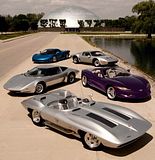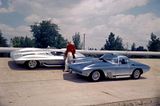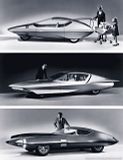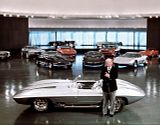The Corvette History
 While the style of a car may be just as important to some as to how well the car runs, automobile manufacturers did not begin to pay attention to car designs until the 1920s. It was not until 1927, when General Motors hired designer Harley Earl, that automotive styling and design became important to American automobile manufacturers. What Henry Ford did for automobile manufacturing principles, Harley Earl did for car design. Most of GM's flamboyant "dream car" designs of the 1950s are directly attributable to Earl, leading one journalist to comment that the designs were "the American psyche made visible." Harley Earl loved sports cars, and GIs returning after serving overseas World War II were bringing home MGs, Jaguars, Alfa Romeos and the like. Earl convinced GM that they needed to build a two-seat sports car. The result was the 1953 Corvette, unveiled to the public at that year's Motorama car show. The original Corvette emblem incorporated an American flag into the design; this was later dropped, since associating the flag with a product was frowned upon. While the style of a car may be just as important to some as to how well the car runs, automobile manufacturers did not begin to pay attention to car designs until the 1920s. It was not until 1927, when General Motors hired designer Harley Earl, that automotive styling and design became important to American automobile manufacturers. What Henry Ford did for automobile manufacturing principles, Harley Earl did for car design. Most of GM's flamboyant "dream car" designs of the 1950s are directly attributable to Earl, leading one journalist to comment that the designs were "the American psyche made visible." Harley Earl loved sports cars, and GIs returning after serving overseas World War II were bringing home MGs, Jaguars, Alfa Romeos and the like. Earl convinced GM that they needed to build a two-seat sports car. The result was the 1953 Corvette, unveiled to the public at that year's Motorama car show. The original Corvette emblem incorporated an American flag into the design; this was later dropped, since associating the flag with a product was frowned upon.
 Taking its name from the corvette, a small, maneuverable fighting frigate (the credit for the naming goes to Myron Scott), the first Corvettes were virtually handbuilt in Flint, Michigan in Chevrolet's Customer Delivery Center, now an academic building at Kettering University. The outer body was made out of a revolutionary new composite material called fiberglass, selected in part because of steel quotas left over from the war. Underneath that radical new body were standard Chevrolet components, including the "Blue Flame" inline six-cylinder truck engine, two-speed Powerglide automatic transmission, and drum brakes from Chevrolet's regular car line. Though the engine's output was increased somewhat, thanks to a triple-carburetor intake exclusive to the Corvette, performance of the car was decidedly lackluster. Compared to the British and Italian sports cars of the day, the Corvette was underpowered, required a great deal of effort as well as clear roadway to bring to a stop, and even lacked a "proper" manual transmission. Up until that time, the Chevrolet division was GM's entry-level marque, known for excellent but no-nonsense cars. Nowhere was that more evident than in the Corvette. A Paxton supercharger became available in 1954 as a dealer-installed option, greatly improving the Corvette's straight-line performance, but sales continued to decline. Taking its name from the corvette, a small, maneuverable fighting frigate (the credit for the naming goes to Myron Scott), the first Corvettes were virtually handbuilt in Flint, Michigan in Chevrolet's Customer Delivery Center, now an academic building at Kettering University. The outer body was made out of a revolutionary new composite material called fiberglass, selected in part because of steel quotas left over from the war. Underneath that radical new body were standard Chevrolet components, including the "Blue Flame" inline six-cylinder truck engine, two-speed Powerglide automatic transmission, and drum brakes from Chevrolet's regular car line. Though the engine's output was increased somewhat, thanks to a triple-carburetor intake exclusive to the Corvette, performance of the car was decidedly lackluster. Compared to the British and Italian sports cars of the day, the Corvette was underpowered, required a great deal of effort as well as clear roadway to bring to a stop, and even lacked a "proper" manual transmission. Up until that time, the Chevrolet division was GM's entry-level marque, known for excellent but no-nonsense cars. Nowhere was that more evident than in the Corvette. A Paxton supercharger became available in 1954 as a dealer-installed option, greatly improving the Corvette's straight-line performance, but sales continued to decline.
 GM was seriously considering shelving the project, leaving the Corvette to be little more than a footnote in automotive history, and would have done so if not for two important events. The first was the introduction in 1955 of Chevrolet's first V8 engine (a 265 in³ {4.3 L}) since 1919, and the second was the influence of a Soviet emigré in GM's engineering department, Zora Arkus-Duntov. Arkus-Duntov simply took the new V8 and backed it with a three-speed manual transmission. That modification, probably the single most important in the car's history, helped turn the Corvette from a two-seat curiosity into a genuine performer. It also earned Arkus-Duntov the rather inaccurate nickname "Father of the Corvette." GM was seriously considering shelving the project, leaving the Corvette to be little more than a footnote in automotive history, and would have done so if not for two important events. The first was the introduction in 1955 of Chevrolet's first V8 engine (a 265 in³ {4.3 L}) since 1919, and the second was the influence of a Soviet emigré in GM's engineering department, Zora Arkus-Duntov. Arkus-Duntov simply took the new V8 and backed it with a three-speed manual transmission. That modification, probably the single most important in the car's history, helped turn the Corvette from a two-seat curiosity into a genuine performer. It also earned Arkus-Duntov the rather inaccurate nickname "Father of the Corvette."
 There have been six generations of the Corvette so far. The generations can be referred to as versions C1 through C6, but the first generation is more commonly referred to as a solid-axle, based on the fact that independent rear suspension (IRS) was not available until 1963. The first generation started in 1953 and ended in 1962, with the noteworthy addition of optional fuel injection in 1957. This new induction system first saw regular use on a gasoline engine two years prior on the Mercedes-Benz 300SL "Gullwing" roadster. Although the Corvette's GM-Rochester fuel injection system used a constant flow style fuel injection system as opposed to the diesel style nozzle metering system of the Mercedes' six cylinders, the system nevertheless produced about 290 hp. The number was derated by Chevrolet's advertising agency for the 283HP/283 in³ (4.6 L) "one hp per cubic inch" slogan, making it the first production engine in history to reach 1 hp/in³. In 1962, the GM Small-Block was enlarged to 327 in³ (5.4 L) and produced a maximum of 360 hp (268 kW). Other early options included Power windows (1956), hydraulically operated power convertible top (1956), four speed manual transmission (mid 1957, and heavy duty brake and suspension option (1957). There have been six generations of the Corvette so far. The generations can be referred to as versions C1 through C6, but the first generation is more commonly referred to as a solid-axle, based on the fact that independent rear suspension (IRS) was not available until 1963. The first generation started in 1953 and ended in 1962, with the noteworthy addition of optional fuel injection in 1957. This new induction system first saw regular use on a gasoline engine two years prior on the Mercedes-Benz 300SL "Gullwing" roadster. Although the Corvette's GM-Rochester fuel injection system used a constant flow style fuel injection system as opposed to the diesel style nozzle metering system of the Mercedes' six cylinders, the system nevertheless produced about 290 hp. The number was derated by Chevrolet's advertising agency for the 283HP/283 in³ (4.6 L) "one hp per cubic inch" slogan, making it the first production engine in history to reach 1 hp/in³. In 1962, the GM Small-Block was enlarged to 327 in³ (5.4 L) and produced a maximum of 360 hp (268 kW). Other early options included Power windows (1956), hydraulically operated power convertible top (1956), four speed manual transmission (mid 1957, and heavy duty brake and suspension option (1957).
The second or mid-year generation, designed by Larry Shinoda under the styling direction of Bill Mitchell, started in 1963 and ended in 1967. 1963 would see the introduction of the new Corvette Sting Ray coupé with its distinctive split rear window and fake hood vents as well as an independent rear suspension. The split rear window was discontinued in 1964 due to safety concerns. Because they made the design too busy, the hood vents were also cut. Power for 1963 was at 365 hp (272 kW) hitting 375 hp (280 kW) in 1964.
 Four-wheel disc brakes were introduced in 1965, as was a "big-block" engine option (the 396 in³ (6.5 L) V8). Side exhaust pipes appeared on the 1965 Stingray and persisted through 1969. Chevrolet would up the ante in 1966 with the introduction of an even larger 427 in³ (7 L) version, creating what would be one of the most collectable Corvettes ever. 1967 saw a L88 version of the 427 introduced which was rated at 430 hp (321 kW), but unofficial estimates place the actual output at 550 hp (410 kW) or more. Only twenty such engines were placed in the 1967 Corvette, and the cars can fetch US$600,000 or more in auction today. From 1967 to 1969, the 1282 cfm Holley triple two-barrel carburetor, or Tri-Power, was available on the 427. The 1967 Corvette originally was going to be the first of the C3 generation; however, due to delays the C3 had to be put off until 1968. Other early options available on the C2 included an AM-FM radio (mid 1963), air conditioning (1963), a telescopic steering wheel (1965) and headrests, presumably to prevent whiplash (1966). Four-wheel disc brakes were introduced in 1965, as was a "big-block" engine option (the 396 in³ (6.5 L) V8). Side exhaust pipes appeared on the 1965 Stingray and persisted through 1969. Chevrolet would up the ante in 1966 with the introduction of an even larger 427 in³ (7 L) version, creating what would be one of the most collectable Corvettes ever. 1967 saw a L88 version of the 427 introduced which was rated at 430 hp (321 kW), but unofficial estimates place the actual output at 550 hp (410 kW) or more. Only twenty such engines were placed in the 1967 Corvette, and the cars can fetch US$600,000 or more in auction today. From 1967 to 1969, the 1282 cfm Holley triple two-barrel carburetor, or Tri-Power, was available on the 427. The 1967 Corvette originally was going to be the first of the C3 generation; however, due to delays the C3 had to be put off until 1968. Other early options available on the C2 included an AM-FM radio (mid 1963), air conditioning (1963), a telescopic steering wheel (1965) and headrests, presumably to prevent whiplash (1966).
The 1965 introduction of the 425 hp 396 in³ big-block was ultimately the harbinger of doom for the Rochester fuel injection system. The 396 in³ option cost $145 while the fuel injected 327 in³ engine cost $500. Few people could justify spending $355 more for 55 hp less. When less than a thousand fuel-injected cars were built in 1965, Chevrolet stopped the program.
In 2004, Sports Car International named the Stingray number five on the list of Top Sports Cars of the 1960s.
The design of this generation had several inspirations. The first was the contemporary Jaguar E-Type, of which Mitchell owned one and enjoyed driving it frequently. Bill Mitchell also sponsored a car known as the "Mitchell Sting Ray" in 1959, because Chevrolet no longer participated in factory racing. This vehicle had the largest impact on the styling of this generation, although it had no top and didn't give away what the coupe would look like. The third inspiration was a mako shark that Mitchell caught while deep-sea fishing.
In 1962 Corvette chief engineer Zora Arkus-Duntov came up with a lightweight version of the C2. Concerned about Ford and what they were doing with the Shelby Cobra, GM planned 100 Grand Sport Corvettes. The plans never came about and only four were built. They were driven by historic drivers such as Roger Penske, A. J. Foyt, Jim Hall, and Dick Guldstrand among others. The Grand Sports, however, had many issues; the aero package made for a very frightful driving experience to say the least. Delmo Johnson said it was "the only car I ever drove that would lift the front wheels off the ground in all four gears." Dick Thompson was the only driver to drive the Grand Sport to victory. He won a Sports Car Club of America race at Watkins Glen. Today there are only five left, cars 001-005 all held by private owners. They are among the most coveted and valuable Corvettes ever built.
The third generation, patterned after Chevrolet's "Mako Shark" (designed by Larry Shinoda), started in 1968 and ended in 1982. This generation has the distinction of being introduced to the motoring public in an unorthodox — and unintended — fashion. 1968 marked the introduction of Mattel's now-famous Hot Wheels line of 1/64-scale die cast toy cars. General Motors had tried their best to keep the appearance of the upcoming car a secret, but the release of the Hot Wheels line several weeks before the Corvette's unveiling had a certain version of particular interest to Corvette fans: the "Custom Corvette", a GM-authorized model of the 1968 Corvette.
In 1969, GM enlarged their small-block again to 350 in³ (5.7 L), and in 1970, the 427 big-block was enlarged to 454 in³ (7.4 L). Power peaked in the 1970 and 1971 models, with the 1970 LT-1 small-block putting out 370 hp (276 kW) and the 1971 454 big-block having its last year of big power with 425 hp (317 kW). In 1972, GM moved to the SAE Net measurement for power (away from the previous SAE Gross standard), which resulted in lower values expressed in hp. Along with the move to unleaded fuel, emission controls, and catalytic converters, power continued to decline and bottomed out in 1975 — the base ZQ3 engine put out 165 hp (123 kW), and the optional L82 engine put out 205 hp (153 kW). Power remained fairly steady for the rest of the C3 generation, ending in 1982 with the 200 hp (149 kW) L83 engine.
Styling changed subtly over the generation. In 1973, the Corvette dropped the front chrome bumpers for a urethane-compound "5 mph" bumper but kept the rear chrome bumpers. In 1974, The rear chrome bumpers became urethane, too, making 1973 the last Corvette model year with any chrome bumpers. 1975 was the last year for the convertible, and 1978 saw the introduction of a glass bubble rear window. In 1980, the Corvette got an integrated aerodynamic redesign that resulted in a significant reduction in drag.
The fourth generation was introduced at the close of 1982 production as a 1984 model and ended in 1996, meaning that there is no such thing as a "1983 Corvette" (though 44 prototype 1983s were built, of which #23 survives today and is housed at the National Corvette Museum in Bowling Green). The C4 is known for its sleek look. Instead of fiberglass, it was made from reaction injected molding plastics, a sheet molding compound. The C4 coupe also was the first Corvette to have a glass hatchback (except for the 1982 Collector's Edition) for better storage access. It also had all new brakes with aluminum calipers. The Corvette C4 came standard with an electronic dashboard with digital liquid crystal displays for speed and rpm. The C4 was a complete redesign of the previous generation, and the emphasis was on handling. The C4 Corvette was proclaimed the best handling car ever when it was released. This handling came with the benefit of a solid, uncompromising ride. The unibody construction used in the C4 was prone to rattles and squeaks due to minimal sound deadening. Also due to the unibody construction, the door sills were quite deep and entry and exit have been likened to a "fall in and climb out" experience. The emergency brake was relocated in 1988 for easier entry and exit.
From 1984 through 1988, the Corvette was available with a "4+3" transmission — a 4-speed manual coupled to an automatic overdrive on the top three gears. This unusual transmission was a synergy that allowed corvette to keep a stout 4 speed, but add an overdrive. As technology progressed, it was replaced by a modern 6-speed manual. However, the C4 performance was hampered by its L98 engine until 1992, when the LT1 was installed, markedly improving the C4's performance. 1996 was the zenith of small block Chevrolet development and the LT4 was installed in all manual transmission-equipped cars.
The fifth generation started in 1997 and ended with the 2004 model year. The C5 was a radical change from the previous generation. The car now had a hydroformed box frame, the transmission was moved to the rear of the car to form an integrated rear-mounted transaxle assembly and is connected to the engine via a torque tube. Gone were the squeaks and rattles of the C4, and in replacement was an incredibly strong frame that would last for at least two more generations. The new C5 was better in every aspect than the C4 it replaced.
The Corvette's 50th Anniversary was celebrated June 20-21, 2003, in Nashville, Tennessee. The venue provided a bonanza of flawlessly restored Corvettes, a chronological display set up by the National Corvette Museum with every model year of the Corvette along with engineering and restoration seminars. The anniversary also brought some Chevrolet Concept Vehicles into focus including the approved-for-production Chevrolet SSR. Also on hand were several Corvette race cars, including the Corvette SS built by Zora Arkus-Duntov and the C5-R that won at Le Mans. Among the many displays were examples of the 2003 50th Anniversary Edition as well as a few 2004 "Commemorative Edition" Corvettes.
Recently, the factory has expanded to build the Cadillac XLR roadster, which shares its platform with the sixth-generation Corvette. Bowling Green is also home to the Corvette Museum, which celebrates this American automotive icon by displaying in chronological order the various regular production models as well as some unique one-off versions created by Chevrolet. The building in Flint in which the first cars were assembled was spun off with GM's Delphi Electronics division and later donated to GMI/Kettering University in the late 1990s. The building has since been remodeled and is now the C.S. Mott Engineering and Science Center, housing the Mechanical Engineering and Chemistry programs. In the garage housing the school's Pontiac Firebird club is a plaque commemorating it as the place where the first Corvette was built.
The sixth generation Corvette has not changed as much as the previous generation Corvette did. The design engineers tried to perfect, not reinvent.
The new C6 gets an overhaul of the suspension geometry, all new bodywork with exposed headlamps (for the first time since 1962), a larger passenger compartment, a larger 6.0 L engine, and a much higher level of refinement. Overall, it is 5.1 in (13 cm) shorter than the C5, but its wheelbase has increased by 1.2 in (3 cm). It is also one in (2.5 cm) narrower, making for a smaller, sportier Corvette. The reduced dimensions were in response to criticism that the C5 Corvette looked too wide—the new body gives the impression of a much sleeker, faster car. Chevrolet hopes the new design will attract buyers of comparable European sports cars like the Porsche 911, but some purists dislike the new styling. The new 6.0 L LS2 V8 produces 400 hp (298 kW) at 6000 rpm and 400 ft·lbf (542 N·m) of torque at 4400 rpm. Its redline is increased to 6500 rpm like the C5 Z06.
The C6 retains its relatively high fuel economy, in part by upshifting to higher gears as soon as possible and in part by its relatively low drag coefficient. Equipped with an automatic transmission, the C6 achieves 18/26 mpg (city/highway), and the manual transmission is slightly better at 18/28. However, some prospective Corvette buyers are surprised to find that the C6's manual transmission is fitted with Computer Aided Gear Shifting (CAGS), obligating the driver to shift from 1st directly to 4th when operating at lower RPMs. While this boosts the EPA's derived fuel economy, thus allowing the buyer to avoid paying the "gas guzzler" tax, it is an open secret that more than a few C6 owners with manual transmissions simply have a $20 aftermarket part (CAGS eliminator) fitted to their vehicle to re-enable a normal 1-2-3-4-5-6 sequence at any rpm. |